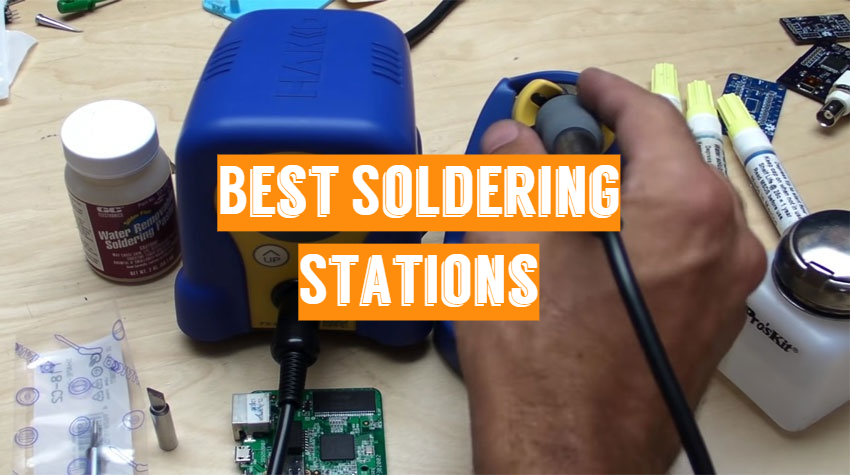




Customer’s Choice: the Best Rated ESP8266 WiFi Modules
[survey_answers id=”292047889″ style=”plain” data=”score”] users answered this survey. Please help us improve this review!
[survey_answers id=”292047889″ style=”piechart” legend=”true”]
Every ESP8266 WiFi module is a pocket-sized, high-fidelity wireless microchip with a complete internet protocol (IP) and transmission control protocol (TCP) stack. The ESP8266 is a WIFI microchip with micro-control and TCP functionality in its most basic version.
This module offers sufficient onboard processing and storage capabilities to enable it to be coupled with sensors and other application-specific devices through its GPIOs with little programming and loading during runtime. Its high on-chip integration allows for minimal external circuitry, and the front-end module is intended to take up as little PCB space as possible.
The ESP8266 features APSD for VoIP apps and Bluetooth coexistence interfaces. Also, this module type has a self-calibrated RF that allows it to function in any environment and does not need any extra RF components.
Applications of the ESP8266 modules:
- Portable electronic projects;
- IoT projects;
- Sockets;
- Bulbs;
- Smart power plugs;
- Commercial WiFi control;
- IP cameras;
- Sensor networks;
- Baby monitors, etc.;
Advantages of ESP8266 WiFi modules:
- Low power consumption;
- Many tutorials;
- Relatively affordable;
- Compatible with Arduino IDE;
Those hobbyists who seek the best ESP8266 WiFi modules should check the product reviews, comparison table and buying guide. Make sure to try a few modules before finding the best for your DIY electronic projects.
KeeYees ESP8266 ESP-12E WiFi WLAN Wireless Module – the best for beginners!
 The KeeYees ESP8266 module offers controllers that are easy to program thanks to the CP2102-USB interface. Before each flash operation, you do not need to hit the reset and flash buttons.
The KeeYees ESP8266 module offers controllers that are easy to program thanks to the CP2102-USB interface. Before each flash operation, you do not need to hit the reset and flash buttons.
The development board combines GPIO, PWM, IIC, 1-Wire, and ADC functionality onto a single board. Smart link networking is supported by the module. It’s a fully integrated unit with all of the necessary resources on board. For Arduino or any development board having I/O pins, it’s quite simple.
After flashing and uploading the application from the Arduino IDE, KeeYees ESP8266s successfully perform simple blink applications.
Pros
- 3 working modes of STA/AP/STA+AP;
- 1 channel ADC;
- Easy to set up and program;
- The headers are pre-installed;
Cons
- Pins are hard to remove;
- No layout guide for the board;
- Some pins can be bent;
It is an advanced WiFi module – both quick and inexpensive. Combine firmware for NodeMCU to make your work go as quickly as possible.
ACEIRMC ESP-12F WiFi Development Board for ESP8266 – the best for USB connection!
 The size of this ACEIRMC module is reduced. It is smaller and hence saves room for your project. This board has 11 digital input/output pins with interrupts, PWM, I2C/1-wire, and a micro USB connector on each pin.
The size of this ACEIRMC module is reduced. It is smaller and hence saves room for your project. This board has 11 digital input/output pins with interrupts, PWM, I2C/1-wire, and a micro USB connector on each pin.
This board is Arduino and WeMos compatible and can be coded using the Arduino IDE. When the CPU is placed into deep sleep mode, e.g., this module operates well in any app that demands extremely low current consumption.
Pros
- Compact;
- Compatible with WeMOS and Arduino;
- A great sealed bag;
- Micro USB connection;
- Affordable;
Cons
- Not recommended for beginners;
- Possible issues with serial communications;
It’s simple to code, unlike other boards that require you to hit buttons at precisely the correct moment or do other acrobatics. With these, all you have to do is plug in the USB cable and press the Arduino IDE’s upload button.
ACROBOTIC ESP8266 ESP-12E Development Board – the best for power supply!
 With Acrobotic’s ESP8266 module, building Internet of Things (IoT) apps has never been easier. Anyone may rapidly get started developing their next internet-connected project with this module.
With Acrobotic’s ESP8266 module, building Internet of Things (IoT) apps has never been easier. Anyone may rapidly get started developing their next internet-connected project with this module.
The development board comes with everything you need to get started constructing ESP8266-powered IoT applications, including passive components, discrete ICs, and a Silicon Labs CP2102 USB to Serial UART adapter.
It’s now fairly simple to create mobile applications that work with hardware. You can quickly construct Android/iOS applications using this module.
Pros
- Designed for IoT and mobile apps;
- Compatible with NodeMCU, Arduino, AT+Commands;
- User-programmable LED;
- Cheap;
- 2 diode-protected power inputs;
Cons
- A bit flimsy;
- Not user-friendly;
This is a great example of it, with a lot of outputs and inputs. For novice users, Acrobotic’s website provides excellent FAQs and tutorials, and everything works flawlessly right out of the box. It’s especially useful for individuals who are just starting started with IoT or who need to get a project up and running quickly.
JacobsParts ESP8266 ESP-12E WiFi Microcontroller – the best for the headers!
 JacobsParts’ ESP-12E WiFi development board includes an ESP8266 microcontroller with 4MB flash memory, a USB TTL serial adapter, a breakout board.
JacobsParts’ ESP-12E WiFi development board includes an ESP8266 microcontroller with 4MB flash memory, a USB TTL serial adapter, a breakout board.
The CH340G USB TTL chip allows for easy USB connectivity and flashing. The ESP-12E is a PCB antenna-equipped shielded breakout board. Power converter circuits, buttons, and breadboard compliant pin headers are all included on the development board.
Pros
- A great breakout board;
- A USB TTL serial adapter;
- Top-notch PCB antenna;
- Budget-friendly;
Cons
- Flimsy;
Power converter circuits, buttons, and breadboard compliant pin headers are all included on this JacobsParts development board.
JacobsParts 3-Pack ESP8266 NodeMCU WiFi Development Board – the best for programming in Lua!
 The ESP8266 development board from JacobsParts is simple to set up. The ESP8266 ESP-12E is used on this board, however, all of its pins have been broken out.
The ESP8266 development board from JacobsParts is simple to set up. The ESP8266 ESP-12E is used on this board, however, all of its pins have been broken out.
This allows the ESP8266 to be used on a breadboard. It also has a built-in micro-USB connector, which makes powering and coding the chip simpler than using a USB-to-serial adapter.
If you wish to write Lua scripts, you may simply load the NodeMCU firmware. Other prominent microcontroller development platforms are also compatible with it.
Pros
- More accessible pins;
- Easy to set up;
- Good for programming in Lua;
- No need to download resetting;
Cons
- Poor quality;
For power and software uploading, this board contains a female Micro-USB connector on the board. This port type may be found on a wide range of consumer goods and mobile phones.
The Buyer’s Guide
Programming
When it comes to coding the ESP8266, there are numerous approaches. When it comes to programming the ESP8266, the Arduino IDE is widely used. Even for newcomers, it may seem to be more comfortable, and for those who’ve been in it for a while, it may seem to be a piece of cake. There are times when you’ll need to use a little technique to move farther on the Arduino.
In this case, you may want to look into using an official SDK to develop it in actual C. ESP8266 Board, an accessible WIFI network, USB cables, a system or PC that can execute the Arduino IDE, and so on are some of the components needed for programming.
NodeMCU
The firmware for the nodeMCU is based on the ESP8266 WiFi SOC. The nodeMCU refers to the firmware, not the development kits, which employ the Lua programming language. The nodeMCU, like the ESP8266, was invented in December 2013 and is widely used in IoT applications.
Power sources
You may power the ESP8266 WiFi module using 2 AA batteries, a PC serial port if you’ve a TTL-Serial-to-USB adapter (don’t attempt to attach the module to a PC serial port manually, you might harm the module or your computer! ), or a USB port if you have a TTL-Serial-to-USB adapter. The ESP Dev Thing board may be powered using LIPO batteries. The LM117 3.3V regulator may be used.
Pinout
One thing to keep in mind while looking at the ESP8266 pinout is that not all pins are acceptable for use, and certain pins are only used for certain purposes. The nodeMCU is often mistaken for the ESP-12E, although this is incorrect. Unlike the ESP-12E, which relies on the UART for recording, nodeMCU relies on the USB. Use numbers in front of the GPIO while programming (AO, DO, D1, D2, D3, D4, D5, D6, D7, D8).
Put the oscilloscope near the edge of the pins due to the variation in the nodeMCU pins, that is, some pins are up and some pins are down. AnalogRead seems to be compatible only with ADC, GPIO 6,7,8, and 11 are not compatible with ADC, digital white is not compatible with ADC.
The logic pins on the microcontroller are all 3.3V, and it’s the most frequent purpose pin. The serial pins, such as the RX and TX pins, are also available. Both are V and 3.3V, however, the RX is the module’s input, whilst the TX is the module’s output5.
Video Tutorial: 5$ Arduino WiFi Module!? ESP8266 mini Tutorial/Review
Final thoughts
Are you looking for a low-cost, easy-to-use microcontroller for a small project? The ESP8266 is the finest solution that comes to mind in this case. Hopefully, this guide helped you to choose some of the modules for your great DIY projects.




The ESP8266 WiFi Module is an amazing piece of technology. It’s inexpensive and can be programmed to do a wide variety of things like Internet connectivity in remote locations, thermostat control for heating and cooling, or automation.